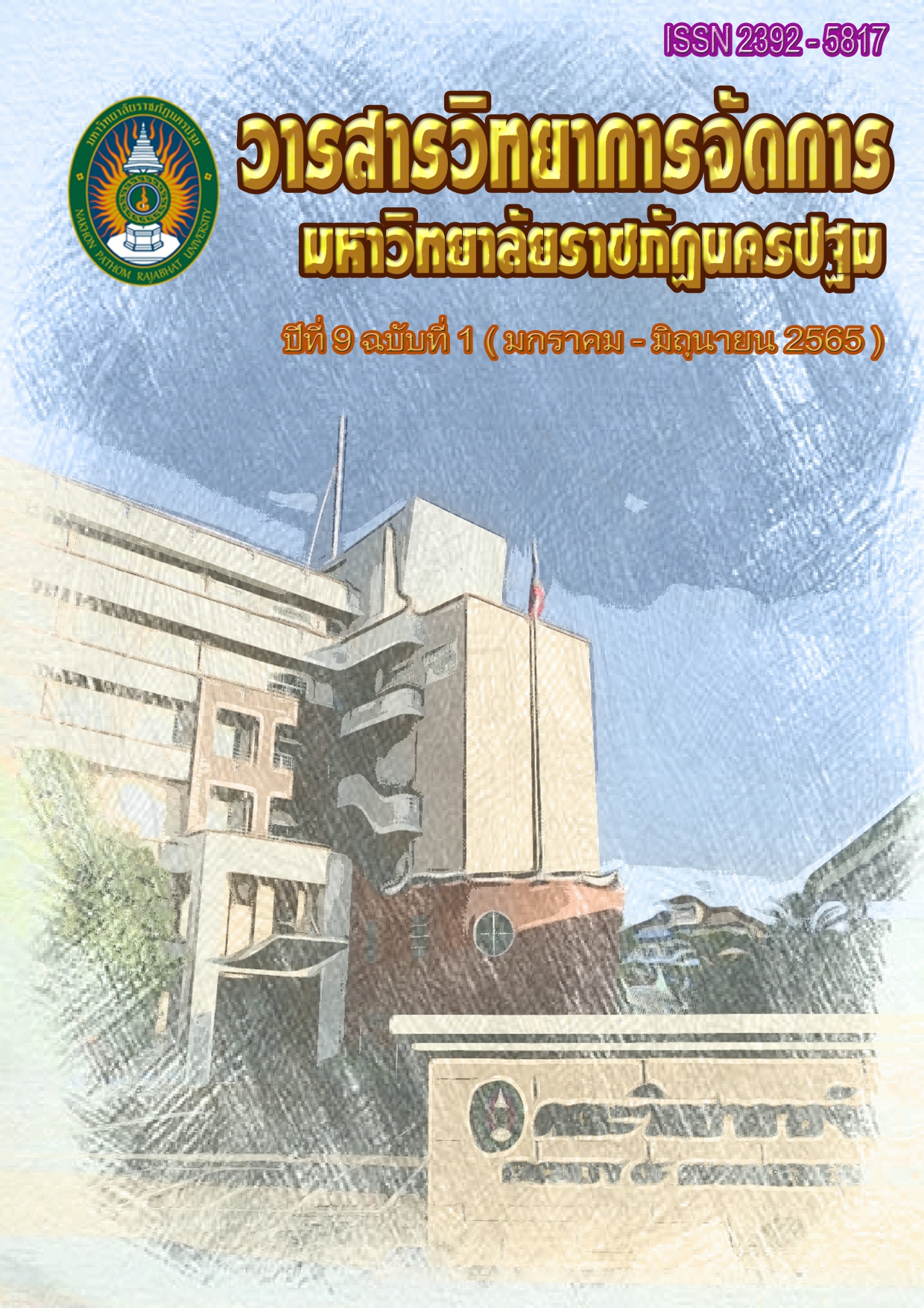Marketing Mix that Affects Skincare’s Buying Behaviors via Social Media (Instagram) of Generation Y in Kanchanaburi Province
Main Article Content
Abstract
This study, Marketing Mix that Affects Skincare’s Buying Behaviors via social media (Instagram) of Generation Y in Kanchanaburi Province, is a quantitative study that aims to 1. Compare Generation Y in Kanchanaburi’s skincare buying behaviors via Instagram and classify the data using the questionnaire participants’ personal information. 2. Study the marketing mix that affects skincare’s buying behaviors via social media (Instagram) of Generation Y in Kanchanaburi province.
This study collects the data from a sample of 401 Generation Y consumers in Kanchanaburi that buys skincare products through Instagram through the method of convenience sampling with the tools of: direct validity questionnaire and reliability analysis tryouts. Along with using the statistics tools including: percentages, averages, standard deviation, t-test, one way ANOVA, regression analysis, and content analysis.
The results are as follows
1. The participants’ skincare buying behaviors via Instagram doesn’t have a notable key difference in personal factors such as: gender, age, and general income. As for the decision-making process, the study found that factors like awareness and information researching tend to differentiate in personal factors of education and occupation. Lastly, in the options selecting process, the final decision and satisfaction testing tend to differentiate in personal factors of gender, education, and occupation.
2. Marketing mix influences that affects Generation Y consumers in Kanchanaburi skincare’s buying behaviors via Instagram includes: Channel of distribution (b=0.33) and Marketing promotions (b=0.52). The equation has a prediction power of 77% and can be presented as a formula as following
Y = 0.16+0.01X1+0.07X2+0.33X3**+0.52X4**
Article history : Received 17 December 2021
Revised 2 May 2022
Accepted 4 May 2022
SIMILARITY INDEX = 7.08 %
Article Details

This work is licensed under a Creative Commons Attribution-NonCommercial-NoDerivatives 4.0 International License.
The views and opinions of the article appearing in this journal are those of the author. It is not considered a view and responsibility of the editorial staff.
References
จุฑารัตน์ ทองสนิท, ชนิกานต์ หวั่งประดิษฐ์, ลักษมณ อนันตประยูร, สุมาลี พิมเขียว, ทาริกา สระทองคำ, และศุภชัย เหมือนโพธิ์. (2562). ปัจจัยที่มีอิทธิพลต่อการตัดสินใจเลือกซื้อผลิตภัณฑ์ดูแลผิวหน้าออร์แกนิกของผู้บริโภคที่อาศัยอยู่ในเขตกรุงเทพมหานคร. วารสารมนุษยศาสตร์และสังคมศาสตร์ มหาวิทยาลัยเอเชียอาคเนย, 3(2). 9.
จิราภา เขมาเบญจพล และ สุทธิลักษณ์ หวังสันติธรรม. (2563). การเปิดรับความพึงพอใจของผู้บริโภคต่อเนื้อหาการตลาดบนอินสตาแกรมสตอรี่กับความตั้งใจซื้อ. วารสารการประชาสัมพันธ์และการโฆษณา, 14(1), 69-70. https://so03.tcithaijo.org/index.php/jprad/article/view/247007
ชนกพร ไพศาลพานิช. (2554). อิทธิพลของวัตถุนิยมและการตระหนักรู้ตนเองต่อพฤติกรรมการซื้อแบบไม่ได้ไตร่ตรองของกลุ่มผู้บริโภคเจเนอเรชั่นวาย. วิทยานิพนธ์ปริญญามหาบัณฑิต, จุฬาลงกรณ์ มหาวิทยาลัย.
ชลชินี บุนนาค และ ปภาภรณ์ ไชยหาญชาญชัย. (2561). การสำรวจรูปแบบการดำเนินชีวิตบนอินสตาแกรม ปริญญานิเทศศาสตรมหาบัณฑิต. สาขาวิชาสื่อสารเชิงกลยุทธ์. มหาวิทยาลัยกรุงเทพ.
ณัฐพร เหล่าสีพงษ์. (2562). กลยุทธ์การจัดการธุรกิจของผลิตภัณฑ์อินทรีย์ (organic) ประเภทเครื่องสำอางและสกินแคร์ ในเขตกรุงเทพมหานคร : มุมมองจากผู้บริโภค. สารนิพนธ์ปริญญาการจัดการมหาบัณฑิต. วิทยาลัยการจัดการ.มหาวิทยาลัยมหิดล.
เดชา เดชะวัฒนไพศาล กฤษยา นุ่มพยา จีราภา นวลลักษณ์ และชนพัฒน์ ปลื้มบุญ. (2557). การศึกษาเจนเนอเรชั่นเอ็กซ์และเจนเนอเรชั่นวายในมุมมองต่อคุณลักษณะของตนเองและความคาดหวังต่อ คุณลักษณะของเจนเนอเรชั่นอื่น. จุฬาลงกรณ์ธุรกิจปริทัศน์, 36(3), 5.
บุญฑวรรณ วิงวอน และ อัจฉรา เมฆสุวรรณ. (2560). ส่วนประสมทางการตลาดที่มีอิทธิพลต่อผลการ ดําเนินงานทางการเงินตามมุมมองของผู้ประกอบการตลาดนัดจังหวัดลําปาง. วารสารวิชาการ มหาวิทยาลัยฟาร์อีสเทอร์น, 11(3), 151.
ปวีณา พานิชชัยกุล และ ธิตินันธุ์ ชาญโกศล. (2563). การวิเคราะห์องค์ประกอบคุณภาพการให้บริการในธุรกิจเครื่องดื่มชานมไข่มุกของเจนเนอเรชั่นวายในเขตกรุงเทพมหานคร. วารสารบริหารธุรกิจและการบัญชี มหาวิทยาลัยขอนแก่น, 4(1), 89.
ภัทราวรรณ ศรีพราย, และ รุ่งรัศมี บุญดาว. (2556). คุณลักษณะเครือข่ายออนไลน์ที่มีผลต่อการตัดสินใจซื้อสินค้าและบริการของผู้บริโภคไทย : กรณีศึกษา Facebook. วารสารบริหารศาสตร์ มหาวิทยาลัยอุบลราชธานี, 2(4), 7-8.
มนัสนันท์ เกียรติสิน นิตยา เจรียงประเสริฐ และ ศรัญญา กันตะบุตร. (2561). ปัจจัยที่มีอิทธิพลต่อความพึงพอใจและแรงจูงใจในการทำงาน: กรณีศึกษาเปรียบเทียบคนเจเนอเรชัน Y และเจเนอเรชัน Z ในเขตกรุงเทพมหานคร. จุฬาลงกรณ์ธุรกิจปริทัศน์, 42(3), 1-18.
วราพร ดำจับ. (2562). สื่อสังคมออนไลน์กับการเรียนรู้ในศตวรรษที่ 21. วารสารศิลปศาสตร์ มหาวิทยาลัยแม่โจ้, 7 (2), 144
วิลัย จันโต และ ธนาสิทธิ์ เพิ่มเพียร. (2561). การธำรงรักษาพนักงานกลุ่มเจนเนอเรชั่นวายที่มี ความสามารถสูงในธุรกิจอุตสาหกรรมอาหารแบบครบวงจร ในเขตกรุงเทพมหานคร. วารสารปัญญาภิวัฒน์, 10(1), 137.
วสุพล ตรีโสภากุล และดุษฎี โยเหลา. (2558). การประยุกต์ใช้ทฤษฏีพฤติกรรมตามแผนในการอธิบายพฤติกรรมการนำข้อมูลบนเฟซบุ๊กแฟนเพจประกอบการตัดสินใจซื้อ. วารสารประชาสัมพันธ์และการโฆษณา, 8(1), 67-68.
ศิริวรรณ เสรีรัตน์ ปริญ ลักษิตานนท์ และ ศุภร เสรีรัตน์. (2552). การบริหารการตลาดยุคใหม่. กรุงเทพฯ: เพชรจรัสแสงแห่งโลกธุรกิจ.
เสาวคนธ์ วิทวัสโอฬาร. (2550). Gen Y จับให้มั่นคั้นให้เวิร์ค. กรุงเทพฯ: กรุงเทพธุรกิจบิซบุ๊ค.
โอภาส เอี่ยมสิริวงศ์. (2556). พาณิชย์อิเล็กทรอนิกส์ (มุมมองด้านการบริหาร). กรุงเทพฯ : ซีเอ็ดยูเคชั่น
Armstrong, G. & Kotler, P. (2009). Marketing, An Introduction. (9th ed.). New Jersey: Pearson Prentice Hall.
Cal Newpost. (2012). Solving Gen Y's Passion Problem. Brighton: Haverd Business Review.
Constine.,J. (2019). Facebook plans new products as Instagram Stories hits 500M users/day. Retrieved January 14, 2020, from https://techcrunch.com/2019/01/30/instagram-stories-500-million/
Etzel, M. J., Walker, B. J., & Stanton, W. J. (2007). Marketing (14th ed.). Boston: McGraw – Hill.
Halse, M., & Mallinson, B. (2009). Investigating popular Internet applications as supporting e-learning technologies for teaching and learning with Generation Y. International Journal of Education and Development using ICT, 5(5), 58-71.
Kemp.S. (2020a). “Digital 2020 Global Overview Report.”, Retrieved October 19, 2020, from https://wearesocial.com/blog/2020/01/digital-2020-3-8-billion-people-use-social-media
Kemp.S. (2020b). “DIGITAL 2020: THAILAND.”, Retrieved October 19, 2020, from
https://datareportal.com/reports/digital-2020-thailand
Phawanthaksa. (2562). โอกาสทองธุรกิจเครื่องสำอางและสกินแคร์. ค้นเมื่อ 4 พฤศจิกายน 2564 จาก https://www.smartsme.co.th/content/218721.
Salleh, S., Hashima, N. H., & Murphy, J. (2015). Instagram marketing: a content analysis of top Malaysian restaurant brands. E-Review of Tourism Research, 6, 1-5.
Shifu Team. (2019). จับตาเทรนด์ E-Commerce ไทย ปี 2020 ทำอย่างไรให้ธุรกิจอยู่รอดในยุคไร้พรมแดน. [ออนไลน์] สืบค้นเมื่อ 23 ตุลาคม 2564. จากhttps://contentshifu.com/ecommerce-trends-priceza/


